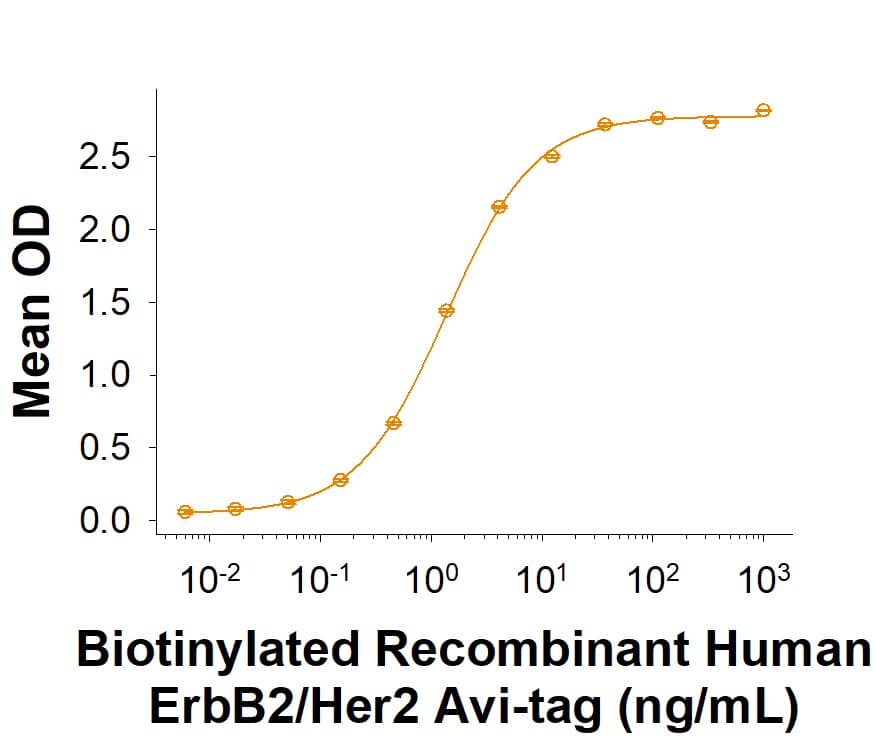Recombinant Human ErbB2/Her2 Avi-tag His-tag Protein, CF
R&D Systems, part of Bio-Techne | Catalog # AVI11356

Key Product Details
Learn more about Avi-tag Biotinylated Proteins
Product Specifications
Source
Chinese Hamster Ovary cell line, CHO-derived human ErbB2/Her2 protein
| Human ErbB2 (Thr23-Thr652) Accession # P04626.1 |
Avi-tag | 6-His tag |
| N-terminus | C-terminus |
Purity
>95%, by SDS-PAGE visualized with Silver Staining and quantitative densitometry by Coomassie® Blue Staining.
Endotoxin Level
<0.10 EU per 1 μg of the protein by the LAL method.
N-terminal Sequence Analysis
Thr23
Predicted Molecular Mass
73 kDa
SDS-PAGE
92-112 kDa, under reducing conditions.
Activity
Measured by its binding ability in a functional ELISA.
When Human ErbB2/Her2 (Research Grade Trastuzumab Biosimilar) Antibody (Catalog # MAB9589) is immobilized at 0.5 µg/mL (100 µL/well), Biotinylated Recombinant Human ErbB2/Her2 Avi-tag His-tag (Catalog # AVI11356) binds with an ED50 of 0.500-6.00 ng/mL.
When Human ErbB2/Her2 (Research Grade Trastuzumab Biosimilar) Antibody (Catalog # MAB9589) is immobilized at 0.5 µg/mL (100 µL/well), Biotinylated Recombinant Human ErbB2/Her2 Avi-tag His-tag (Catalog # AVI11356) binds with an ED50 of 0.500-6.00 ng/mL.
Scientific Data Images for Recombinant Human ErbB2/Her2 Avi-tag His-tag Protein, CF
Biotinylated Recombinant Human ErbB2/Her2 Avi-tag His-tag Protein Binding Activity.
When Human ErbB2/Her2 (Research Grade Trastuzumab Biosimilar) Antibody (MAB9589) is immobilized at 0.5 µg/mL (100 µL/well), Biotinylated Recombinant Human ErbB2/Her2 Avi-tag His-tag Protein (Catalog # AVI11356) binds with an ED50 of 0.500-6.00 ng/mL.Biotinylated Recombinant Human ErbB2/Her2 Avi-tag His-tag Protein SDS-PAGE.
2 μg/lane of Biotinylated Recombinant Human ErbB2/Her2 Avi-tag His-tag Protein (Catalog # AVI11356) was resolved with SDS-PAGE under reducing (R) and non-reducing (NR) conditions and visualized by Coomassie® Blue staining, showing bands at 92-112 kDa.Formulation, Preparation and Storage
AVI11356
| Formulation | Lyophilized from a 0.2 μm filtered solution in PBS with Trehalose. |
| Reconstitution | Reconstitute at 250 μg/mL in PBS. |
| Shipping | The product is shipped at ambient temperature. Upon receipt, store it immediately at the temperature recommended below. |
| Stability & Storage | Use a manual defrost freezer and avoid repeated freeze-thaw cycles.
|
Background: ErbB2/Her2
References
- Coussens, L. et al. (1985) Science 230:1132.
- Yamamoto, T. et al. (1986) Nature 319:230.
- Kanai, Y. et al. (1995) Biochem. Biophys. Res. Commun. 208:1067.
- Codony-Servat, J. et al. (1999) Cancer Res. 59:1196.
- Carraway, K.L. 3rd et al. (1994) J. Biol. Chem. 269:14303.
- Emkey, R. and C.R. Kahn (1997) J. Biol. Chem. 272:31172.
- Schaefer, G. et al. (1999) J. Biol. Chem. 274:859.
- Schlessinger, J. (2000) Cell 103:211.
- Hellyer, N.J. et al. (2001) J. Biol. Chem. 276:42153.
- Daly, R.J. (1999) Growth Factors 16:255.
Long Name
Receptor Tyrosine Protein Kinase ErbB2
Alternate Names
CD340, HER2, Neu Oncogene, NGL, TKR1
Gene Symbol
ERBB2
UniProt
Additional ErbB2/Her2 Products
Product Documents for Recombinant Human ErbB2/Her2 Avi-tag His-tag Protein, CF
Product Specific Notices for Recombinant Human ErbB2/Her2 Avi-tag His-tag Protein, CF
For research use only
